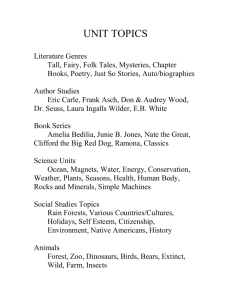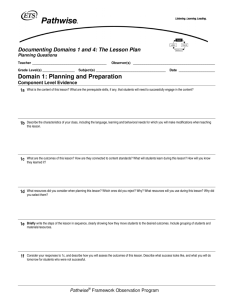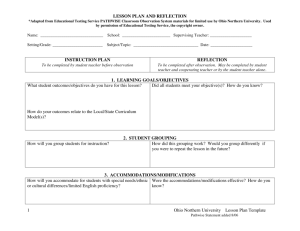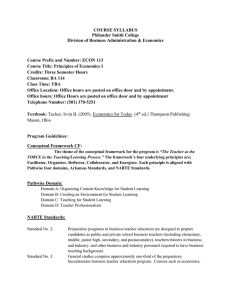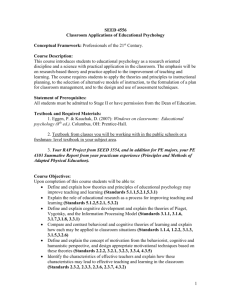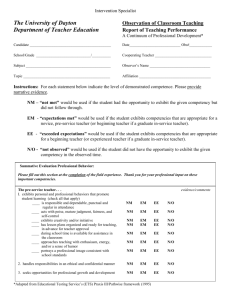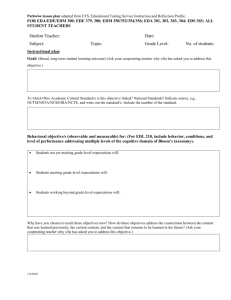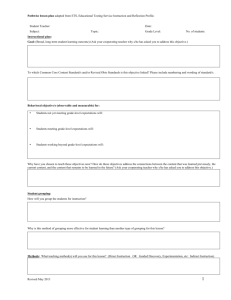COURSE SYLLABUS Philander Smith College Division of Business
advertisement
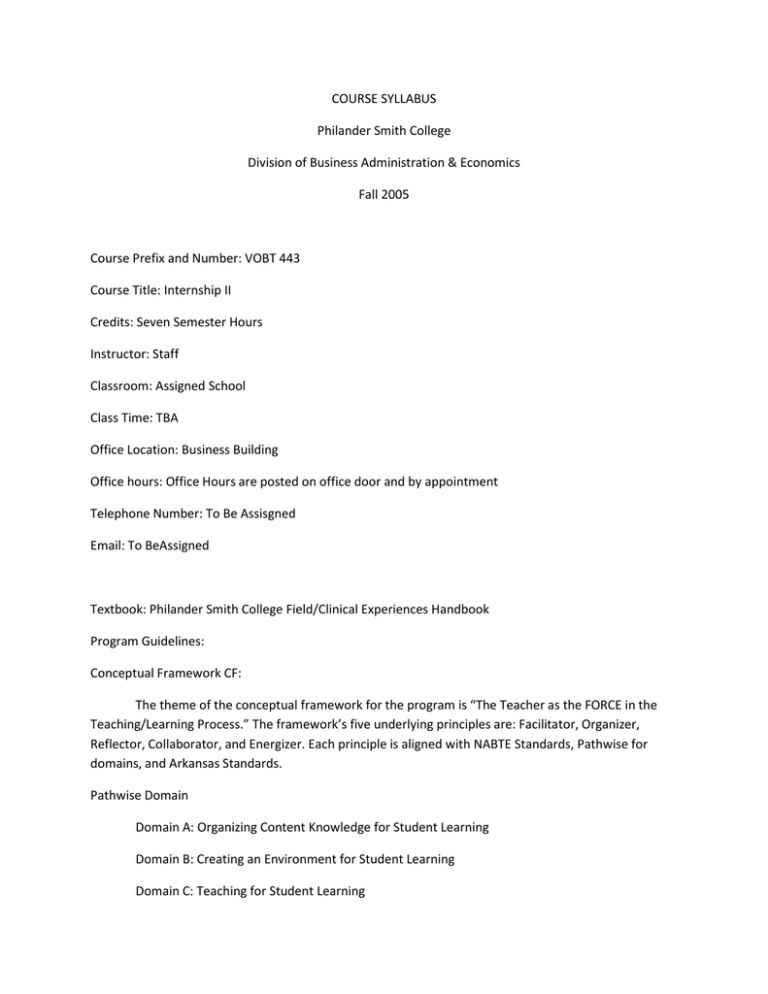
COURSE SYLLABUS Philander Smith College Division of Business Administration & Economics Fall 2005 Course Prefix and Number: VOBT 443 Course Title: Internship II Credits: Seven Semester Hours Instructor: Staff Classroom: Assigned School Class Time: TBA Office Location: Business Building Office hours: Office Hours are posted on office door and by appointment Telephone Number: To Be Assisgned Email: To BeAssigned Textbook: Philander Smith College Field/Clinical Experiences Handbook Program Guidelines: Conceptual Framework CF: The theme of the conceptual framework for the program is “The Teacher as the FORCE in the Teaching/Learning Process.” The framework’s five underlying principles are: Facilitator, Organizer, Reflector, Collaborator, and Energizer. Each principle is aligned with NABTE Standards, Pathwise for domains, and Arkansas Standards. Pathwise Domain Domain A: Organizing Content Knowledge for Student Learning Domain B: Creating an Environment for Student Learning Domain C: Teaching for Student Learning Doamin D: Teaching Professionalism NABTE Standards: Standard No. 2: Preparatory programs in business teacher educationare designed to prepare candidates as public and private school business teachers (including middle, junior high, secondary, and postsecondary), teachers/trainers in business and industry, and other business and industry personnel required to have business teaching background. Standard No. 3: General studies comprise approximately one-thirs of the preparatory baccalaureate business teacher education program. Courses such as economics, business statistics, and business technology pllications may be counted as part of the general education studies. Standard No. 4: Business studies comprise approximately one-half of the preparatory baccalaureate degree program or the baccalaureate degree earnedprior to entering the business teacher education preparatory program. Standard No. 5: Professional studies comprise approximately one-sixth of the baccalaureate degree program or a comparableamount of course work if pursuing an advanced degree teacher certification program ora teacher certification program. These studiesinclude educational foundation studies, teaching-learning theory, pedagogical strategies, and field experiences. Standard No. 6: Prospective business teachers apply the results of educational research, develop concepts of research, and interpret professional literature wich addresses researchand development. Course Description: Candidates will spend one day per week for ten weeks (60 clock hours) in a high school classroom. This clinical experience will focus on working with students in large and small groups. Candidates will be expected to complete assignments related to their on campus courses during the classroom placement. During this field placement, candidates will continue to develop their professional skills to enter their specialty area of education. Candidates are expected to use technology throughout the teaching/learning process. COURSE OBJECTIVES: 1. The student will become familiar with subject matter and assignments. NABTE 2.1,2.2, 3.2, 3.3, 3.4, 5.3, 5.6, 5.8, 6.1, 6.2; Pathwise Domain A1, B3; CF 1.1.1, 2.2.2 2. The student will be able to select, construct, and arrange exhibit materials for bulletin boards wich spport, extend or teach concepts. NABTE 2.2, 2.11, 5.6, 5.8; Pathwise Domain A1, A4; CF 2.2.2, 2.2.7 3. The stuent will begin a file or notebook of teaching ideas. NABTE 2.1, 2.2, 5.6; Pathwise Domain A1, A2; CF 2.2.2, 2.2.4. 4. The student will become familiar with a variety of text materials and resources on the subject taught. NABTE 2.1, 4.1, 4.3, 4.4, 4.5, 4.6, 4.7, 4.8; Pathwise Domain A3, B4; CF 2.2.6 5. The student will assist in the preparation of materials for the special needs students. NABTE 2.2, 2.11, 5.11; Pathwise Domain A2, A4; CF 2.2.6 6. The student will be able to introduce units of work and assist in the teaching of one or more lessons. NABTE 2.1, 3.2, 3.3, 4.4; Pathwise Domain B3; CF 1.1.3 7. The student will assist in the preparation and use of multimedia resources. NABTE 2.1, 2.11, 4.2, 4.7; Pathwise Domain A4, D3, CF 2.2.7, 3.3.6 8. The student will be able to give individual instruction when a pupil needs help. NABTE 2.1; Pathwise Domain B4; CF 1.1.4 9. The student will be able to supervise study groups and committee group work. NABTE 2.1; Pathwise Domain B4; CF 1.1.4 10. The student will be able to conduct short periods of teaching. NABTE 2.1, 5.5; Pathwise Domain B1, B2; CF 1.1.1, 1.1.2 11. The student will become familiar with support services and resources. NABTE 2.1, 4.2, 4.7; Pathwise Domain D3; CF 3.3.6 12. The student will deveope skills in planning, presenting and evaluating instruction. NABTE 2.1, 5.1; Pathwise Domain C2; CF 4.4.4 13. The student will assist in the preparation and use of technology in the teaching/learning process. NABTE 2.1, 4.2, 4.7; Pathwise Domain D3; CF 3.3.6 14. The student will continue reflective journal writing. NABTE 2.1, 3.9, 5.3, 5.9; Pathwise Domain D1; CF 3.3.1, 3.3.2 15. The student will continue portfolio development. NABTE 2.1, 3.2, 3.3, 4.2, 4.4, 4.7; Pathwise Domain B3, D3; CF 1.1.3, 3.3.6 Dispositions: 1. Demonstrate a sense of caring. 2. Establish rapport with students. 3. Demonstrate a sense of efficancy. 4. Demonstrate a positive attitude towards children. 5. Demonstrate respect for children. Technology: 1. Basic operations and concepts a. Students demonstrate a sound understanding of the nature and operation of technology systems. b. Students are proficient in the use of technology. 2. Social, ethical, and human issues a. Students understand the ethical, cultural, and societal issues related to technology. b. Students practice responsible use of technology systems, information and software. c. Students deveople positive attitudes towards technology uses that support lifelong learning, collaboration, personal pursuits, and productivity. 3. Technology productivity tools a. Students use technology tools to enhance learning, increase productivity and promote creativity. b. Students use productivity tools to collaborate in constructing technology-enhanced models, preparing publications, and producing other creative works. 4. Technology communication tools a. Students use telecommunications to collaborate, publish and interact with peers, experts and other audiences. b. Students use a variety of media and formats to communicate information and ideas effectively to multiple audiences. 5. Technology research tools a. Students use technology to locate, evaluate and collect information from a variety of sources. b. Students use technology tools to process data and report results. c. Sudents evaluate and select new information resources and technological innovations based on appropriateness to specific tasks. 6. Technology problem-solving and decision-making tools a. Students use technology resources for solving problems and maing informed decisions. b. Students employ technology in the development of strategies for solving problems in the real world. Assignments, Evaluations, Procedures and Grading Policy: Portfolio for Field Experiences 1. Include school profile, seating plan, rules and procedures, classroom management plan and daily attendance. 200 Points 2. Include 10 lesson plans using assigned format. 200 Points 3. Include photographs and student work. Grading Policy: Grades will be assigned according to the percentage of toal points earned based on the following scale: Grading Scale: 100-90 A 89-80 B 79-70 C 69-60 D 59-0 F Teaching Strategies: Lecture Discovery Learning X Discussion Small group Activites X Cooperative Learning X Demonstration Medeling Role Playing X Technology/Media Presentation Problem Solving X Team Teaching X Individualized Instruction topics covered in class). X Other (look up websites information pertaining to Teaching Models: X Direct Instruction X General inquiry Model Inductive Model Deductive Model References: Students with Disabilities Policy: This course adheres to the stdents with disabilities policy outlined in the 2005-2007 Philander Smith College Catalog. Attendance Policy: This course adheres to the attendance policy outlined in the 2005-2007 Philander Smith College Catalog Websites: www.google.com http://www.awesomelibrary.org/cgi-bin/search-awl.cgi www.ask.com http://www.eric.ed.gov
